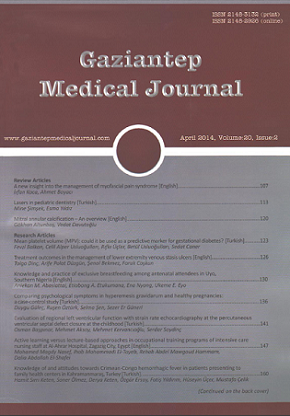Totally implantable central venous port catheters: a 10- year single-center experience
DOI:
https://doi.org/10.5455/GMJ-30-155606Keywords:
Catheter-related infections, central venous catheterization, implantable cathetersAbstract
Totally implantable port catheters facilitate the administration of cytotoxic drugs, antibiotics, blood products and fluids in children with hematologic and oncologic diseases or organ failures. The aim of this study is to evaluate the characteristics of patients and results of port catheter insertions. We retrospectively reviewed demographic and clinical properties of 224 children who underwent implantable port catheter insertions in order to receive long-term intravenous treatment between 2003 and 2013. Port catheters were implanted in 224 patients (124 female and 100 male). The mean age of patients was 5.04±3.75 years (2 months-18 years). The most common oncologic diagnose was acute lymphoblastic leukemia. Seventy-two port catheters were removed due to infection in 40 and completion of treatment in 32 patients. 25 of 152 port catheters inserted via subclavian puncture and 15 of 90 port catheters inserted via jugular cut down were removed due to infection (P=0.965). Port catheters were inserted 3 times in 3 patients and 2 times in 15 patients. The mean duration of usage was 442.5±381.3 days among patients whose catheters were removed due to infection and 964.4±298.8 days among patients whose treatments were completed (P<0.001). Pneumothorax or hemothorax were observed in none of the cases. Four patients needed revision of eroded skin over the chamber. We were not able to remove the catheter from right jugular vein in a patient due to firm adhesion of catheter to the vessel wall. Catheter migration occurred in one patient and removed by endovascular procedure. Implantable port catheters provide safe long term intravenous access for patients with malignant and chronic diseases.
Metrics
References
Uderzo C, D’Angelo P, Rizzari C, Viganò EF, Rovelli A, Gornati G, et al. Central venous catheter-related complications after bone marrow transplantation in children with hematological malignancies. Bone Marrow Transplant 1992;9(2):113-7.
Cairo MS, Spooner S, Sowden L, Bennetts GA, Towne B, Hodder F. Long-term use of indwelling multipurpose silastic catheters in pediatric cancer patients treated with aggressive chemotherapy. J Clin Oncol 1986;4(5):784-8.
Gves J, Ensminger W, Niederhuber J, Liepman M, Cozzi E, Doan K, et al. Totally implanted system for intravenous chemotherapy in patients with cancer. Am J Med 1982;73(6):841-5.
Stanislav GV, Fitzgibbons RJ Jr, Bailey RT Jr, Mailliard JA, Johnson PS, Feole JB. Reliability of implantable central venous access devices in patients with cancer. Arch Surg 1987;122(11):1280-3.
Braam KI, Veening MA, Schouten-van Meeteren AY, van Dulmen-den Broeder E, Heij HA. Totally implantable venous access device in children with cancer lead to disfiguring scar. Pediatr Hematol Oncol 2013;30(2):154-64.
White AD, Othman D, Dawrant MJ, Sohrabi S, Young AL, Squire R. Implantable versus cuffed external central venous catheters for the management of children and adolescents with acute lymphoblastic leukaemia. Pediatr Surg Int 2012;28(12):1195-9.
Rauthe G, Altmann C. Complications in connection with venous port systems: prevention and therapy. Eur J Surg 1998;24(3):192-9.
O’grady NP, Alexander M, Dellinger EP, Gerberding JL, Heard SO, Maki DG, et al. Guidelines for the prevention of intravascular catheter-related infections. Am J Infect Control 2002;30(8):476-89.
Maki DG, Mermel LA. Infections due to infusion therapy. In: Bennett JV, Brachman PS, eds. Hospital infections. Philadelphia: Lippincott-Raven, 1998;689-724.
Zhang Q, Jiao L, Zhou H. Comparison of implantable central venous ports with catheter insertion via external jugular cut down and subclavian puncture in children: single center experience. Pediatr Surg Int 2009;25(6):499-501.
Chandrasekaran A, Somasundaram J. Surgical placement of totally implantable venous access device-an institutional experience. Indian J Pediatr 2014 (in press).
Hengartner H, Berger C, Nadal D, Niggli FK, Grotzer MA. Port-A-Cath infections in children with cancer. Eur J Cancer 2004;40(16):2452-8.
Groeger JS, Lucas AB, Thaler HT, Friedlander-Klar H, Brown AE, Kiehn TE, et al. Infectious morbidity associated with long-term use of venous access devices in patients with cancer. Ann Intern Med 1993;119(12):1168-74.
Wilson GJ, van Noesel MM, Hop WC, van de Ven C. The catheter is stuck: complications experienced during removal of a totally implantable venous access device. A single-center study in 200 children. J Pediatr Surg 2006;41(10):1694-8.
Jones SA, Giacomantonio M. A complication associated with central line removal in the pediatric population: retained fixed catheter fragments. J Pediatr Surg 2003;38(4):594-6.
Huang SC, Tsai MS, Lai HS. A new technique to remove a “stuck” totally implantable venous access catheter. J Pediatr Surg 2009;44(7):1465-7. 17. Fan WC, Wu CH, Tsai MJ, Tsai YM, Chang HL, Hung JY, et al. Risk factors for venous port migration in a single institute in Taiwan. World J Surg Oncol 2014;12:15.
Orme RM, McSwiney MM, Chamberlain-Webber RF. Fatal cardiac tamponade as a result of a peripherally inserted central venous catheter: a case report and review of the literature. Br J Anaesth 2007;99(3):384-8.
Downloads
Published
How to Cite
Issue
Section
License
Copyright (c) 2023 European Journal of Therapeutics

This work is licensed under a Creative Commons Attribution-NonCommercial 4.0 International License.
The content of this journal is licensed under a Creative Commons Attribution-NonCommercial 4.0 International License.


















